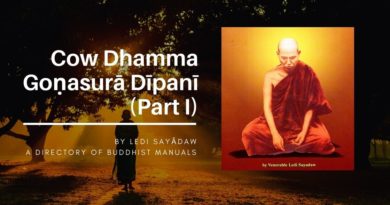THE ABHIDHARMA – PART IV: ANALYSIS OF CONSCIOUSNESS
THE ABHIDHARMA – PART IV: ANALYSIS OF CONSCIOUSNESS
Because of its importance and scope, I will dedicate three chapters to the analysis of consciousness within Abhidharma philosophy. In this chapter I look at some of the systems for classifying consciousness and also at the sense-sphere consciousness in particular.
To understand why we begin our Abhidharmic analysis of experience with consciousness, it is important to remember the therapeutic concern of Buddhist philosophy in general and the Abhidharma in particular. The starting point of Buddhist thought is the truth of suffering. Suffering is a problem of consciousness; only that which is conscious can suffer. Consciousness is subject to suffering because of ignorance, or fundamental not-knowing, which divides consciousness into subject and object, into a self and an other-than-self (i.e., the objects and people around the self).
In Buddhism, ignorance is defined as the notion of a permanent, independent self and its object. Once we have this division of consciousness into a self and an other-than-self, we have suffering, because tension is created between the two. We also have craving and aversion, because we want those things that support the self and are averse to those things that are not conducive to the self.
This division or discrimination between the self (or subject) and the other-than-the-self (or object) is the fundamental cause of suffering. Such a division is possible because of ignorance — the belief in a real self existing independently and in opposition to the other-than-self. Thus it is not surprising that the Abhidharma should turn first to an analysis of subjectivity and objectivity. Indeed, when we examine the teaching of the five aggregates, we see that form (rupa) is the objective component, while name (nama), consciousness, and the mental aggregates of volition, perception, and feeling are the subjective component. Before looking at how this division affects the Abhidharmic analysis of consciousness, we must be clear about what it means. In Buddhism, this division does not mean that we have an essential, irreducible duality of mind and matter. Buddhism is not concerned with mind and matter as ultimate metaphysical facts but with mind and matter as they are experienced. Mind and matter are forms of experience, not essences. This is why Buddhism is a phenomenological, not an ontological, philosophy, and why the division of mind and matter in Buddhism is a phenomenological division.
There are two systems for classifying consciousness in the Abhidharma: objective and subjective. Objective classification refers to the objects of consciousness, while subjective classification refers to the nature of consciousness.
Objective classification primarily takes into account the direction in which consciousness is oriented. Within this objective scheme, there is a division into four classes of consciousness: (1) the sense-sphere consciousness, or consciousness directed toward the world of sense desire (kamavachara); (2) the consciousness directed toward the sphere of form (rupavachara); (3) the consciousness directed toward the formless sphere (arupavachara); and (4) the consciousness directed toward nirvana (lokuttara). The first three classes of consciousness are worldly (lokiya) and are concerned with the world of conditioned things. The fourth class, also known as supramundane consciousness (alokiya chitta), refers to the transcendental direction of consciousness (lokuttara) and is the consciousness of the four types of noble ones–the stream-winner, once-returner, non-returner, and liberated one (see Chapter 5).
The object of the kamavachara is material and limited; the object of the rupavachara is not material but is still limited; and the object of the arupavachara is not material and is unlimited. If we look at these three in order, we find (a) a material and limited object, (b) an immaterial but still limited object, and (c) an immaterial and unlimited object of consciousness. All three types of consciousness are directed toward mundane objects. There is a progressive unification and homogenization in the object of each consciousness. The object of the consciousness of the sphere of sense desire is the most proliferated and differentiated, those of the form and formless types of consciousness are increasingly less proliferated. The fourth type of consciousness is directed toward a transcendental type of object.
Let us now look at the subjective classification of consciousness. This consciousness has to do with the nature of the subjective consciousness itself and is also divided into four classes: the wholesome consciousness (kusala), the unwholesome consciousness (akusala), the resultant consciousness (vipaka), and the ineffective or functional consciousness (kiriya).
The wholesome and unwholesome classes are karmically active classes of consciousness; in other words, they have karmic potential. The resultant and functional types of consciousness are not karmically active and do not have karmic potential. The resultant class cannot bring about results because it is itself the result, while the functional class cannot do so because its potentiality is exhausted in the action itself.
We can thus place the wholesome and unwholesome categories in the more general category of karmically active consciousnesses, and the resultant and functional types into the category of passive consciousnesses that do not have karmic potential.
It might be useful to look for a moment at the meaning of the terms ‘wholesome’ (kusala) and ‘unwholesome’ (akusala), and then at the definition of the wholesome and unwholesome categories of subjective consciousness. Wholesome means ‘what tends toward cure’ or ‘what tends toward desirable results.’ Here we are again reminded of the therapeutic concern of Buddhist philosophy. Unwholesome means ‘what tends toward undesirable results’ or ‘what tends toward perpetuation of suffering.’ The terms ‘wholesome’ and ‘unwholesome’ are also related to skillful and unskillful, or intelligent and unintelligent, moments of consciousness. However, for convenience, people still sometimes refer to wholesome and unwholesome consciousness as good and bad, moral and immoral. ‘Wholesome’ and ‘unwholesome’ can also be defined with reference to the three wholesome and unwholesome root causes (non-greed, non ill-will, and non-delusion, and greed, ill-will, and delusion, respectively). Greed, ill-will, and delusion are the derivative forms of fundamental ignorance, which is the mistaken notion of a self as opposed to what is other-than-self. Ignorance in its fundamental sense might be likened to the root of a tree, and greed, ill-will, and delusion to its branches.
The karmic potential of a moment of consciousness conditioned by any of the three unwholesome causes is unwholesome, while the potential of a moment conditioned by any of the three wholesome causes is wholesome. These wholesome and unwholesome classes of consciousness are karmically active, and they are followed by a resultant class–in other words, by the ripened results of those wholesome and unwholesome actions. The inactive or functional class refers to actions that are not productive of further karma, and that also do not result from wholesome and unwholesome karma, such as the actions of enlightened ones–the Buddhas and Arhats–and deeds of indifferent or neutral karmic content.
In addition to these two general systems for classifying consciousness — the objective, which classifies consciousness according to its object and direction, and the subjective, which classifies consciousness according to its nature — we have a third system in which consciousness is distinguished according to feeling, knowledge, and volition.
In the classification according to feeling, every conscious factor partakes of an emotional quality: agreeable, disagreeable, or indifferent. These three can be expanded into five by dividing the agreeable category into mentally agreeable and physically agreeable, and the disagreeable category into mentally disagreeable and physically disagreeable. There is no category of physically indifferent consciousness because indifference is primarily a mental quality.
In the classification in terms of knowledge, again we have a threefold division: conscious factors accompanied by knowledge of the nature of the object, conscious factors unaccompanied by knowledge of the nature of the object, and conscious factors accompanied by definite wrong views about the nature of the object. These can also be called the presence of correct knowledge, the absence of correct knowledge, and the presence of erroneous knowledge.
Finally, in the classification according to volition, there is a twofold division into automatic and volitional consciousness–in other words, moments of consciousness that are automatic in nature, and moments that have an intentional element.
Let us now look at the sense-sphere consciousness (kamavachara). There are fifty-four types of consciousness in this category, which divide into three groups:
The first group consists of twelve factors that are karmically active and that have unwholesome karmic potential. The twelve can be subdivided into factors conditioned by one of the three unwholesome conditions of greed, ill-will, and delusion.
The second group consists of eighteen reactive or passive factors of consciousness, which can be further broken down into those that are resultant and those that are functional. Fifteen of the eighteen are resultant, and refer in general terms to experiences that are agreeable or disagreeable, the result of wholesome or unwholesome factors experienced through the five physical senses and the sixth mental sense. The remaining three are functional, having no karmic potential and not being the consequence of karmically active wholesome or unwholesome factors.
The third category consists of twenty-four wholesome factors of consciousness that are karmically active and thus have karmic potential conditioned by non-greed, non-ill-will, and non-delusion.
Within the class of sense-sphere consciousness, therefore, we have fifty-four types of consciousness that can be analyzed in terms of active and passive, wholesome and unwholesome, resultant and functional, and even in terms of feeling, knowledge, and volition.
I want to conclude by spending a few moments on the multivalent nature of terms in the Abhidharma in particular and in Buddhism in general. The factors of consciousness listed in the Abhidharma, and the terms used to describe them, have different values and meanings according to the functions they perform. Failure to understand this leads to confusion about Abhidharmic classifications.
Even in the early years of the Abhidharma, there were critics who failed to understand that the factors in it are classified functionally, not ontologically. What this means is that if you survey the factors of consciousness listed in the Abhidharma literature, you find the same factor occurring in different categories. Your initial conclusion may be that there is a great deal of repetition in Abhidharmic material, but this is not the point. The presence of the same factor in different categories is due to its functioning differently in each one.
The commentary to the Dhammasangani (Classification of Factors) records the objection of repetition raised by an opponent. It replies with the analogy that when a king collects taxes from people, he does so not on the basis of their existence as identifiable individuals, but of their functions as earning entities. (This is also the case today, when one pays taxes on the basis of being a property owner, a salaried worker, on the earnings of one’s stocks and bonds, and so forth.) In the same way, the factors enumerated in the Abhidharma occur in different categories because in each case it is the factor’s function that counts, not its essence.
This is also the case with terms. We need to understand terms in context–by the way they are used–rather than imposing rigid, essentialistic, and naturalistic definitions. Take, for instance, ‘suffering’ (dukkha) and ‘happiness’ (sukha). In the analysis of the factors of consciousness, these terms mean physical suffering and physical happiness. Yet when we talk about dukkha in the context of the first noble truth, it includes not only four physical sufferings but also four mental sufferings. Similarly, sankhara means simply ‘volition’ in one context but ‘all compounded things’ in another.
Thus when we study the Abhidharma, we need to understand the words in context. If we keep this in mind, we will be adopting the phenomenological spirit of Buddhist philosophy and will find it easier to approach the significance of what is being said. Otherwise, we will find ourselves trapped into rigid, unworkable definitions of terms and rigid, unhelpful ideas about factors of experience.








